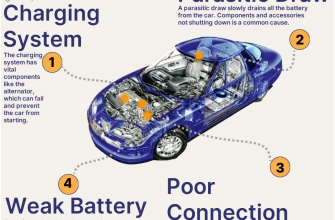Imagine cruising down the highway, music playing, and the wind in your hair, when suddenly, your vehicle’s dashboard lights flicker ominously. Your heart races as you realize that your car battery may be failing. Battery failure while driving is not just an inconvenience; it can pose serious risks to both you and your vehicle. In this article, we’ll explore the causes of battery failure, how to recognize the signs, and what to do if it happens to you.
- What Causes Battery Failure?
- Recognizing the Signs of Battery Trouble
- What To Do If Your Battery Fails While Driving
- Preventative Measures
- Understanding the Aftermath of Battery Failure
- Assessing Your Vehicle
- Staying Prepared for the Road
- The Psychological Impact of Battery Failure
- After the Incident: What Comes Next?
- Evaluating Your Driving Habits
- Investing in Battery Technology
- Emergency Preparedness: Being Ready for Anything
- Mindset Shift: Embracing Resilience
What Causes Battery Failure?
Understanding the reasons behind battery failure can help drivers take proactive measures. Here are some common causes:
- Age of the Battery: Most car batteries have a lifespan of 3 to 5 years. As they age, their ability to hold a charge diminishes.
- Corrosion: Corrosion on battery terminals can hinder the electrical flow, leading to power loss.
- Extreme Temperatures: Both hot and cold weather can affect battery performance. High temperatures can cause battery fluid to evaporate, while extreme cold can reduce battery capacity.
- Electrical Drain: Leaving lights on or using electronics without the engine running can deplete your battery’s charge.
- Faulty Alternator: If the alternator is not functioning properly, it may not be charging the battery effectively.
Recognizing the Signs of Battery Trouble
Knowing the warning signs of battery failure can help you avoid being stranded. Look out for:
- Dim Lights: If your headlights or dashboard lights are dim or flickering, it may indicate a weak battery.
- Slow Engine Crank: If your engine struggles to start or takes longer than usual to crank, your battery might be losing power.
- Warning Lights: Pay attention to any battery or check engine warning lights on your dashboard.
- Unusual Smells: A rotten egg smell can indicate a leaking battery, which is a serious issue.
What To Do If Your Battery Fails While Driving
Experiencing battery failure while driving can be alarming, but staying calm and following these steps can help you navigate the situation:
- Find a Safe Spot: If you notice signs of battery failure, look for a safe place to pull over, away from traffic.
- Turn Off Electrical Accessories: Turn off your radio, air conditioning, and any other electrical accessories to conserve battery power.
- Check Your Dashboard: Look for warning lights or messages that might indicate battery issues.
- Attempt to Restart: If safe, try turning off your vehicle and restarting it. If it starts, consider driving to a nearby mechanic for a check-up.
- Call for Assistance: If your vehicle does not start, it’s best to call for roadside assistance or a tow truck.
Preventative Measures
Taking preventative steps can help extend the life of your battery and reduce the risk of failure:
- Regular Maintenance: Have your battery and electrical system checked regularly as part of your vehicle maintenance routine.
- Clean Terminals: Keep battery terminals clean and free of corrosion to ensure proper electrical connectivity.
- Monitor Age: Keep track of your battery’s age and consider replacing it before it becomes an issue.
- Limit Electrical Use: Avoid using electrical components when the engine is off, and ensure lights are turned off when the car is not in use.
Battery failure while driving can be a daunting experience, but understanding the causes, recognizing the signs, and knowing how to respond can empower you as a driver. By taking preventative measures, you can help ensure that you stay safe on the road and avoid the headaches that come with battery failure. Remember, a little awareness goes a long way!
Understanding the Aftermath of Battery Failure
Once you’ve experienced battery failure while driving, the implications can extend beyond the immediate inconvenience. It’s essential to assess not only your vehicle but also your driving habits and preparedness for future incidents. A proactive approach can safeguard against similar situations and ensure a smoother driving experience.
Assessing Your Vehicle
After resolving a battery issue, it’s wise to conduct a thorough inspection of your vehicle. Here’s what to check:
- Battery Condition: Inspect the battery for any signs of corrosion, cracks, or leaks. If you notice anything unusual, consider replacing the battery.
- Alternator Functionality: Ensure your alternator is functioning properly. A faulty alternator can lead to repeated battery issues. A mechanic can perform a load test to confirm its health.
- Electrical System Check: Have a professional check your vehicle’s electrical system to ensure there are no hidden drains or faults that could lead to future failures.
Staying Prepared for the Road
Preparation is key when it comes to avoiding battery failure in the future. Here are some tips to keep in mind:
- Emergency Kit: Equip your vehicle with an emergency kit that includes jumper cables, a flashlight, basic tools, and a first-aid kit. This can be invaluable if you find yourself in a bind.
- Regular Checks: Make it a habit to check your battery’s health and connections periodically. A quick visual inspection can often reveal problems before they escalate.
- Know Your Vehicle: Familiarize yourself with how your car’s electrical systems operate. Understanding your vehicle’s unique needs can help you anticipate potential issues.
The Psychological Impact of Battery Failure
Experiencing battery failure can be stressful and may leave a lasting impression. It’s normal to feel anxious about driving after such an event. Here are some strategies to cope:
- Mindfulness Techniques: Practicing mindfulness or deep-breathing exercises can help reduce anxiety before driving. Take a moment to center yourself and focus on the road ahead.
- Driving Confidence: Gradually build your confidence by taking short drives in familiar areas. This can help you regain your comfort behind the wheel.
- Share Your Experience: Talking about your experience with friends or fellow drivers can provide support and reassurance. You might find comfort in knowing others have faced similar challenges.
Battery failure while driving is more than just a momentary setback; it can be a catalyst for positive change in how you approach vehicle maintenance and driving safety. By understanding the causes, recognizing the signs, and equipping yourself with knowledge and tools, you can transform a potentially alarming experience into an opportunity for empowerment. Remember, a well-prepared driver is a confident driver, and confidence is key to enjoying every journey on the road;
After the Incident: What Comes Next?
Once you’ve dealt with the immediate effects of battery failure, it’s essential to consider the next steps for both your vehicle and your peace of mind. The aftermath can shape your driving habits, vehicle maintenance routine, and overall confidence on the road.
Evaluating Your Driving Habits
Reflect on your driving habits and consider making adjustments to minimize the risk of future battery issues. Here are some suggestions:
- Track Your Usage: Maintain a log of your vehicle’s electrical usage, especially if you frequently use features like GPS, heating, or entertainment systems while the engine is off.
- Routine Checks: Get into the habit of performing routine checks on your battery health and electrical system, especially before long trips.
- Stay Informed: Learn about your vehicle’s specific requirements and quirks. Understanding how your car operates can help you anticipate potential problems.
Investing in Battery Technology
As technology evolves, so do the options for car batteries. Consider investing in advanced battery technology that provides greater reliability:
- Opt for AGM Batteries: Absorbent Glass Mat (AGM) batteries are known for their durability and resistance to vibration, making them a solid choice for vehicles that require a lot of electrical power.
- Consider Lithium-Ion: While more expensive, lithium-ion batteries offer exceptional performance and longevity, reducing the likelihood of unexpected failures.
- Smart Battery Management Systems: Look for vehicles equipped with smart battery management systems that optimize charging and discharging cycles to prolong battery life.
Emergency Preparedness: Being Ready for Anything
Battery failure can happen to anyone, anytime. Enhancing your emergency preparedness extends beyond just having jumper cables. Here’s how you can be ready:
- Know Your Resources: Familiarize yourself with local roadside assistance services and save their numbers for quick access.
- Mobile Apps: Download apps that provide roadside assistance, vehicle diagnostics, and even battery health monitoring. Some apps can alert you to potential battery issues before they become serious.
- Emergency Contact: Keep a list of emergency contacts in your vehicle, including friends or family who can assist in a pinch.
Mindset Shift: Embracing Resilience
Battery failure, while inconvenient, can be reframed as a learning opportunity. Embrace a mindset that views challenges as stepping stones to growth:
- Resilience Building: Each experience, even the frustrating ones, can fortify your resilience. Learn to adapt and embrace the unexpected.
- Stay Positive: Maintain a positive outlook when facing vehicle troubles. Your attitude can influence your ability to cope and find solutions efficiently.
- Community Support: Engage with local driving communities or online forums to share experiences and gain insights from others who have faced similar challenges.
Battery failure while driving can be an unnerving experience, but it’s also an opportunity to cultivate knowledge and preparedness. By understanding the causes, recognizing the warning signs, and taking proactive steps, you can reduce the likelihood of future failures and enhance your driving experience. Embrace the journey, stay informed, and remember: every setback is a setup for a comeback. Whether you’re navigating city streets or embarking on long road trips, being aware and prepared will keep you moving forward with confidence.
This content aims to provide further insight into handling the aftermath of battery failure while driving, encouraging proactive measures and a resilient mindset.










This article is incredibly informative! It breaks down the causes of battery failure in a way that is easy to understand. Great job!
This article covers everything you need to know about car batteries! I feel much more prepared to handle any issues that may arise now.
Such a well-written piece! The explanation of how extreme temperatures affect battery performance was really insightful. I learned a lot.
Great job on this article! I had no idea that corrosion could impact my car battery so much. This is definitely going on my must-read list for car maintenance.
I found the section on recognizing signs of battery trouble particularly helpful. I’ll definitely keep an eye out for those warning signs!
I appreciate how this article highlights the importance of battery maintenance. It’s something that often gets overlooked by many drivers.
Excellent read! The tips on what to do if your battery fails while driving were very practical and reassuring. Thanks for sharing!